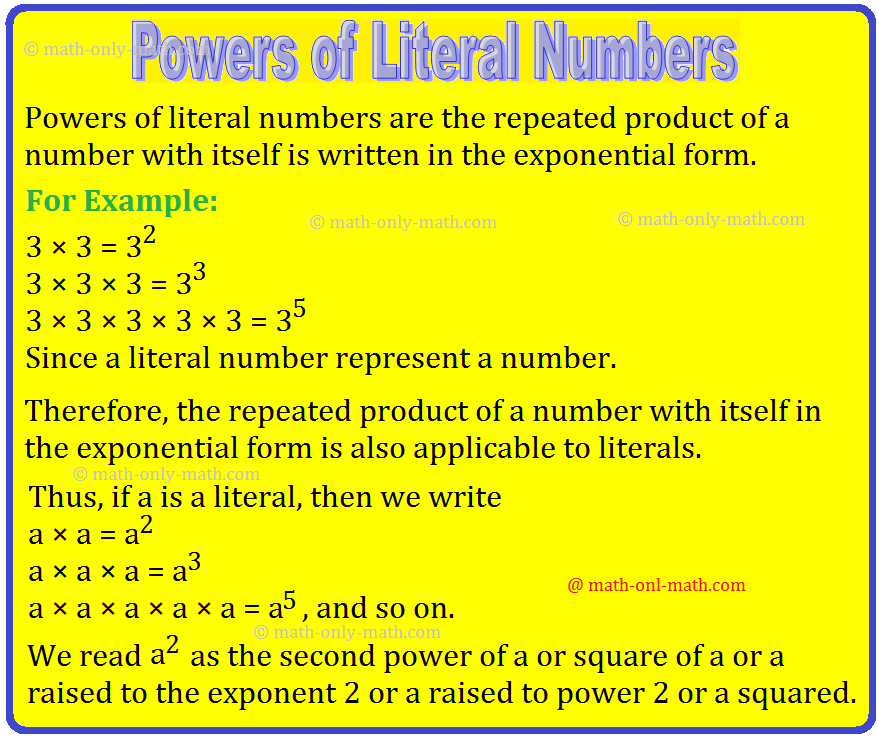Subscribe to our ▶️ YouTube channel 🔴 for the latest videos, updates, and tips.
Powers of Literal Numbers
Powers of literal numbers are the repeated product of a number with itself is written in the exponential form.
For Example:
3 × 3 × 3 = 33
3 × 3 × 3 × 3 × 3 = 35
Since a literal number represent a number.
Therefore, the repeated product of a number with itself in the exponential form is also applicable to literals.
Thus, if a is a literal, then we write
a × a × a = a3
a × a × a × a × a = a5, and so on.
Also, we write
7 × a × a × a × a = 7a4
4 × a × a × b × b × c × c = 4a2b2c2
3 × a × a × b × b × b × c × c × c × c as 3a2b3c4 and so on.
We read a2 as the second power of a or square of a or a raised to the exponent 2 or a raised to power 2 or a squared.
Similarly, a5 is read as the fifth power of a or a raised to exponent 5 or a raised to power 5 (or simply a raised 5), and so on.
In a2, a is called the base and 2 is the exponent or index.
Similarly, in a5, the base is a and the exponent (or index) is 5.
It is very clear from the above discussion that the exponent in a power
of a literal indicates the number of times the literal exponent has been
multiplied by itself.
Thus, we have
a15 = a × a × a × a……………… repeatedly multiplied 15 times.
Conventionally, for any literal a, a1 is simply written as a,
i.e., a1 = a.
Also, we write
a × a × a × b × b = a3b2
7 × a × a × a × a × a = 7a5
7 × a × a × a × b × b = 7a3b2
These are the examples of powers of literal numbers.
Working Rules for Power Literal:
Step I: Take any variable, say 'a'.
Step II: Multiple the variable two times or three times
i.e., m × m is written as m2 (called 'm squared')
or m × m × m = m3 (called 'm cubed').
Step III: In m5 m is the base and 5 is the exponent.
NOTE:
1. Instead of writing a1 write a only.
2. The product of a and b can be written as a × b or ab.
Solved Examples on Powers of Literal Numbers:
1. Find out the base and exponent of the following:
(i) p2
(ii) t7
(iii) 54
Solution:
(i) ln p2, p is the base and 2 is the exponent.
(ii) In t7, t is the base and 7 is the exponent.
(iii) In 53, 5 is the base and 4 is the exponent.
Properties of Multiplication of Literals
6th Grade Page
From Powers of Literal Numbers to HOME PAGE
Didn't find what you were looking for? Or want to know more information about Math Only Math. Use this Google Search to find what you need.



New! Comments
Have your say about what you just read! Leave me a comment in the box below. Ask a Question or Answer a Question.